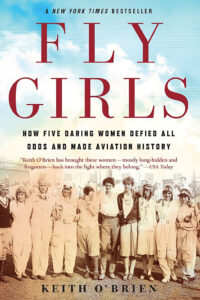Florence Klingensmith: A pioneer in women’s aviation history
2023 Air Race Classic, which originates in Grand Forks this year, traces roots back to early days of aerial racing

Editor’s note: In honor of March as Women’s History Month, UND Today presents this story that pays tribute to Florence Klingensmith, a North Dakota aviation pioneer; and previews the 46th Annual Air Race Classic, which will begin at Grand Forks International Airport in June and includes a team of four UND students.
****
The 1933 air race accident that ended the life of North Dakota’s first licensed woman pilot was used as an excuse to diminish women’s role in aviation.
Florence Klingensmith was born in 1904 and grew up in Moorhead, Minn., launching her aviation career from Hector Field in Fargo, N.D. However, the nature of her untimely death for decades masked her contributions to the burgeoning aviation field in the 1920s and 1930s.
“Florence Klingensmith was from the Fargo-Moorhead area and became North Dakota’s first licensed woman pilot,” said Beth Bjerke, associate dean for UND aerospace and professor for aviation. “She was truly one of the first air racers who rose to national prominence by learning to fly and being very successful.”
While Klingensmith wasn’t as well-known as Amelia Earhart – perhaps the most famous woman pilot of the era – her influence on women in aviation was significant. She was 29 when she lost her life during an air race in Chicago, determined to demonstrate that when it came to flying, women had just as much skill as men.
In the spirit of Klingensmith and other women pioneers in air racing, this summer, the 46th Annual Air Race Classic will begin at the Grand Forks International Airport and include a team of four UND students. They will compete with other women to fly a 2,400-mile course from North Dakota to Homestead, Fla., from June 20-23.
“We are hosting the start of the Air Race Classic, an all-female race with its roots back in the 1920s,” said Bjerke.

“The race isn’t about getting to Homestead, Fla., first; it’s about flying as lightweight as possible and knowing little tricks and tweaks,” she explained. “But mainly it’s understanding the weather, knowing when to take off and what altitudes to fly at.”
Following in Klingensmith’s footsteps, members of UND’s 2023 Air Race Classic team are: pilot Grace Heron, a senior from Tampa, Fla., majoring in aviation safety, commercial aviation and sociology; copilot Sadie Blace, a sophomore from Mankato, Minn., majoring in commercial aviation and aviation management; navigator Tracy Mitchell, a sophomore from Billings, Mont., majoring in commercial aviation and unmanned aircraft systems; and ground coordinator Ashley Almquist, a freshman from Bay Village, Ohio, majoring in commercial aviation and aviation safety.

UND’s decade of air racing
As UND’s John D. Odegard School of Aerospace Sciences celebrates its 10th anniversary of participating in the Air Race Classic and Grand Forks prepares to host the event, it’s worth noting that during Women’s History Month, Klingensmith was among the pioneering women pilots in the early years of aviation and air racing.
Mark Peihl, senior archivist and 36-year employee with the Historical and Cultural Society of Clay County, did detailed research on Klingensmith for a 1991 article he wrote for the organization’s newsletter. He spoke to people who remembered Klingensmith, calling her “an amazing woman with an amazing story.”
“She was known all over the country, a household name at the time,” he said. “She was a very remarkable character in her own right, someone who was absolutely fearless and would try anything. She’s one of my favorite characters from Clay County history.”
But the circumstances of her death in an air race crash while competing against male pilots caused her to fade into the shadows of history. Keith O’Brien, a former Boston Globe reporter, changed that with the 2018 publication of his book, “Fly Girls: How Five Daring Women Defied All Odds and Made Aviation History.”

Klingensmith is one of five women aviators featured in the book. The other four women pilots are Earhart, Ruth Elder, Ruth Nichols and Louise Thaden. A chapter of “Fly Girls” is devoted to Klingensmith and her aviation exploits. The book became a New York Times best seller and helped revive Klingensmith’s historical importance in the aviation field.
In a 2018 interview with GBH News, O’Brien said, “Florence Klingensmith, of this bunch, was just, objectively speaking, the most skilled pilot. She flew in the pylon races. Not only did she fly in the pylon races, she won them and actually competed against the men. That required the utmost coordination and skill. Florence was incredible at it.”
The daredevil from Moorhead
Klingensmith spent her early years on a small farm north of Moorhead before her family moved into town. She gained a reputation as a daredevil, racing motorcycles and working as a sky diver and an airshow stunt girl.
Determined to fly, she earned money to complete electrical school and then worked as an apprentice airplane mechanic at Fargo’s Hector Field while taking flying lessons. She raised money from local businesses to buy her first airplane, which she named “Miss Fargo.”
North Dakota’s first licensed woman pilot launched an aviation career that included winning some of the biggest air races of the day, earning the Amelia Earhart Trophy and setting a world record for flying the most continuous loops – a 4 ½ hour flight during which she completed 1,078 loops. Klingensmith earned the nickname “Tree Tops” for her flamboyant flying style.
One of her goals was to demonstrate that women could compete against men, who almost always had the advantage of wealthy sponsors, enabling them to fly the latest and fastest aircraft.

As O’Brien wrote in his book, “It was not surprising, then, that the few women who dared to enter the elite, male-dominated aviation fraternity endured a storm of criticism and insults. They weren’t aviators, as far as men were concerned.”
Klingensmith’s big break came in 1933 when, in conjunction with the World’s Fair in Chicago, she was signed on to fly in the national Frank Phillips Trophy Race against a field of male pilots. O’Brien compared the event to today’s Super Bowl game.
Klingensmith would fly one of the fastest aircraft of its time, the Gee Bee Sportster built by the Granville Brothers. The stubby plane designed around a powerful radial engine, had a reputation for being difficult and dangerous to fly.
In fact, Lowell Bayless, a pilot for the Granville Brothers, was killed while trying to set an air speed record in the plane when it lost a wing. The aircraft suffered a number of fatal crashes, but, as O’Brien wrote in his book, “Plane manufacturers had no required regulations – and instructors, no required training.”
Thus, fatal crashes at air races were common occurrences in those days.
A sad situation
Klingensmith started the race strong, impressing spectators with her flying ability. She was in fourth place and challenging for third when disaster struck. The Bee Gee began to shed its fabric skin, causing Klingensmith to leave the race and fly away from the crowded airfield. Before she could bail out, the airplane plunged to the ground, killing her.
Rather than demonstrating that women had the ability to compete against men, Klingensmith’s fatal crash had the opposite effect. It was said that women pilots were too weak, too easily confused to participate in air racing. One Chicago newspaper went so far as to speculate that Klingensmith might have been menstruating when she died.
“The whole situation was so sad,” Peihl said. “She had such a great opportunity to prove herself, and she probably would have, if not for having a defective aircraft. If she would have finished third in that race, it would have been huge.”
Although it’s taken nearly 90 years to recognize Klingensmith’s contributions to aviation history, the path she opened for women aviators is coming to light. In 2021, the city of Moorhead named its municipal airport Florence Klingensmith Field. A mural downtown and exhibits at the airport celebrate and call attention to her many accomplishments.
Peihl’s article quotes the “Flying Parson,” Rev. J.C. Brown, who eulogized Klingensmith’s during her funeral in Moorhead.
“If she could speak to us now, she would tell us not to lose faith in aviation because of the tragedy that ended her flying career,” Brown said. “She would say it was not usual, but in the pursuit of the thrills upon which she thrived.”




